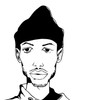Installation view of The Times at The FLAG Art Foundation, 2017. Photography by Steven Probert.
Installation view of The Times at The FLAG Art Foundation, 2017. Photography by Steven Probert.
Linda Stillman. Wether Weather, 2017. NYT Newspaper clippings, acrylic medium on paper. 22 x 30 inches.
Mike Cockrill. Exploding Businessmen Bunnies (New York Times), 2017. Fabric, paper printouts, archival glue, on paper. 32 x 40 inches.
Yuken Teruya. Minding My Own Business (The New York Times, March 18, 2015), 2015. Paper, wire, and glue. 2 1/2 x 12 1/2 x 12 1/2 inches
Rirkrit Tiravanija. untitled 2017 (tomorrow is the question, january 21, 2017), 2017. Acrylic and newspaper on linen. 89 ¼ x 73 ¼ inches. Collection of Jack K. Cayre. All images courtesy of The Flag Art Foundation.
Lorraine O'Grady. Cutting Out the New York Times, You Can Succeed in Your Own Business, 1977. Toner Ink on adhesive paper. 11 sheets, 8 ½ x 11 inches each.
